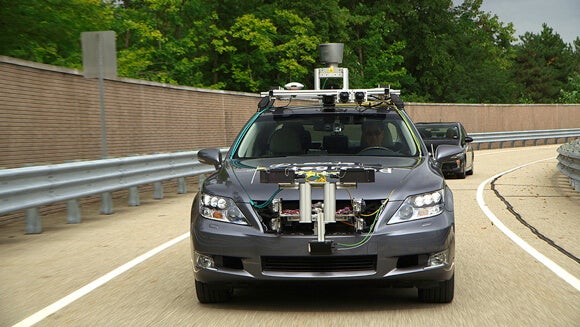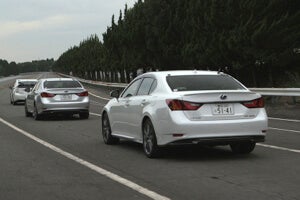Toyota Joins Slew of Major Automakers Promising Self-Driving Technology This Decade
Toyota was the latest to step onboard the self-driving car hype machine this week when they announced they would offer a car with “automated driving technologies” by the mid-2010s. In recent months, several carmakers—Tesla, Nissan, BMW—have published forecasts of robot cars inside the next decade.

Share
Toyota recently added its voice to a chorus of major automakers promising self-driving systems when the firm announced it would offer a car with “automated driving technologies” by the mid-2010s. In recent months, several manufacturers—Tesla, Nissan, BMW—have published forecasts of robot cars inside the next decade.
Toyota, the latest to promise automated car tech, is more modest than some of its competitors. The Japanese firm’s Automated Highway Driving Assist (AHDA) system is, as the name suggests, for highways only. Once available, the system will keep the car in its lane using cameras and radar and maintain a safe following distance by wirelessly transmitting acceleration data to nearby cars.
Similar features (though not yet as automated as Toyota's promised tech) are already available in high end cars like the 2014 Mercedes S-Class. However, the S-Class maintains following distances using radar and cameras.
Toyota's Moritaka Yoshida, managing officer of safety technology, told the Wall Street Journal that the technology is supposed to "help driving, not support a completely automated vehicle." Yoshida said Toyota will continue research into fully autonomous driving tech but doesn't have plans to market fully self-driving systems.
Toyota says they’re pursuing automation in driving to reduce accidents, save gas, ease traffic jams, and assist the elderly. The usual list of motives. Though the announced capabilities aren’t revolutionary, perhaps that they’ll be available at an affordable price point in the near future shows the technology maturing.
Making a splash under the broad “self-driving” banner is clearly considered a good marketing move right now.
But what each firm is forecasting as "self-driving" varies. That is, they want the appeal of self-driving, while still, understandably covering their bases.
One Nissan executive, for example, said they’d bring “fully autonomous vehicles to the market by 2020.” The firm then went on to say in a press release that their systems would require less input from drivers, not no input.
BMW said they expect highly automated cars by 2020 (eg., no driver monitoring in stop-and-go traffic on the highway), but the fully automated sort won’t show up until 2025. Tesla CEO Elon Musk believes he can make 90% automated autos by 2015—but beyond that, the problem gets much more difficult and will take longer to solve.
Be Part of the Future
Sign up to receive top stories about groundbreaking technologies and visionary thinkers from SingularityHub.


Presumably, since Google’s self-driving car hit the roads, traditional car companies are feeling pressure to prove themselves relevant and cutting edge. They’d like to regain control of a conversation in danger of being co-opted by Silicon Valley. (As Toyota noted in its press release, they've been pursuing such tech since the late 90s and have tested automated systems on public roads in the US and Japan for several years.)
Good PR or not, recent forecasts aren't just hot air. Existing technologies make robotic cars in the next decade plausible.
That said, if you're excited but suitably skeptical of self-driving's biggest claims, Gartner’s “hype cycle” may be a useful compass. According to Gartner, when a technology first becomes possible, we project its success too aggressively.
That first flush of excitement peaks and turns to disillusion as the technology fails to meet inflated expectations in the promised timeframe. After early predictions become fodder for ridicule, the tech more modestly reaches towards its potential—notably, still falling short of what was projected at peak excitement.
Gartner recently placed some of today’s emerging technologies on the hype cycle curve. Self-driving cars were past the midline of the steep climb toward inflated expectations.
Even so, just because a technology has seized our imaginations doesn’t mean it won’t pan out over reasonable timeframes. Gartner gives self-driving technology five to ten years before it matures and plateaus somewhat below peak expectations.
Of course, the hype cycle is a general guide and Gartner's forecasts opinions. But if Gartner is right, we won’t see fully automated cars by 2015 or 2020. However, in the not too distant future, driving will be much more automated—adding a degree of safety, saving some gas, and automating the worst bits of driving (like rush hour).
Image Credit: Toyota
Jason is editorial director at SingularityHub. He researched and wrote about finance and economics before moving on to science and technology. He's curious about pretty much everything, but especially loves learning about and sharing big ideas and advances in artificial intelligence, computing, robotics, biotech, neuroscience, and space.
Related Articles

This Light-Powered AI Chip Is 100x Faster Than a Top Nvidia GPU

These Robots Are the Size of Single Cells and Cost Just a Penny Apiece

Hugging Face Says AI Models With Reasoning Use 30x More Energy on Average
What we’re reading


